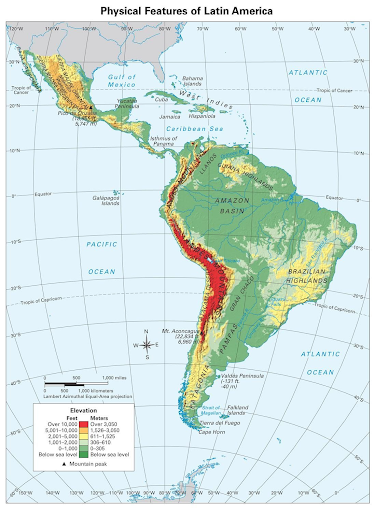Biodiversity & Environment
State of the Climate on Latin America and the Caribbean 2020: WMO
- 21 Aug 2021
- 5 min read
Why in News
Recently, the World Meteorological Organization (WMO) has released a report on the impacts of climate change and extreme weather in Latin America and the Caribbean.
- 2020 was a year of unprecedented heatwaves, droughts, forest fires, cyclones and food insecurity for the region.
- The Intergovernmental Panel on Climate Change in its sixth assessment report had highlighted the impact of climate change on the Indian Subcontinent.
World Meteorological Organization
- About:
- It is an intergovernmental organization with a membership of 192 Member States and Territories. India is a member.
- It originated from the International Meteorological Organization (IMO), which was established after the 1873 Vienna International Meteorological Congress.
- Establishment:
- Established by the ratification of the WMO Convention on 23rd March 1950, WMO became the specialized agency of the United Nations for meteorology (weather and climate), operational hydrology and related geophysical sciences.
- Headquarters:
- Geneva, Switzerland.
- Reports released by WMO:
- State of the Global Climate
- Greenhouse Gas Bulletin
Key Points
- Rise in Temperature:
- 2020 was among the three warmest years in Central America and the Caribbean and the second warmest year in South America.
- Sea surface temperature in the Tropical North Atlantic Ocean was significantly warmer than normal throughout the year.
- Severe heat waves dominated the region through most of the year, with temperatures soaring above 40°C several days in a row.
- Intense Rainfall:
- Intense rainfall resulted in landslides, floods and flash floods in the rural as well as urban areas of Central and South America towards the end of 2020.
- Forest Fires and Cyclones:
- Deforestation has only increased in the last four years due to clearing for cattle pasture and degradation from fires.
- Deforestation in the Amazon River Basin, which stretches across nine countries in South America and stores 10% of global carbon, has already led to a decline in its ability to regulate climate.
- The Atlantic basin recorded as many as 30 cyclones in 2020 — the highest so far in a single year.
- Deforestation has only increased in the last four years due to clearing for cattle pasture and degradation from fires.
- Impact:
- Extreme weather events affected over 8 million people across Central America, exacerbating food insecurity in countries already crippled by economic shocks, Covid-19 restrictions, and conflict.
- Suggestions:
- Hazard-specific monitoring systems such as FAO's Agricultural Stress Index System (ASIS) is an example of a useful tool to allow governments to issue early warning alerts for specific sectors like agriculture.
- Develop Early Warning Systems (EWS) and contingency plans.
- Early warning systems were underdeveloped in the region, particularly in South America.
- Planting of the mangroves, an ecosystem of which can help sequester three-four times more carbon than most forests.
- Area under mangrove plantation declined 20% between 2001 and 2018 in the region.
- Greater political commitment and more financial support is needed to strengthen EWS and operational weather, climate and hydrological services to support risk management and adaptation.
Latin America and Caribbean (LAC) Region
- About:
- Latin America is generally understood to consist of the entire continent of South America in addition to Mexico, Central America, and the islands of the Caribbean.
- It encompasses 33 countries.
- Geographical Features:
- Amazon River, Caribbean Sea, Gulf of Mexico, Pacific Ocean, Panama Canal, Andes Mountains, Sierra Madre Mountains, and Atacama Desert.
- Major Economic Blocs:
- MERCOSUR: The Southern Common Market consists of five countries in southern Latin America: Argentina, Brazil, Paraguay, Uruguay and Venezuela.
- CARICOM: The Caribbean Community consisting of 19 island groups: Antigua and Barbuda, the Bahamas, Barbados, Belize, Dominica, Grenada, Guyana, Haiti, Jamaica, Montserrat, St. Kitts and Nevis, Saint Lucia, St. Vincent and the Grenadines, Suriname, and Trinidad and Tobago.
- CAN: The Andean Community consists of four countries: Bolivia, Colombia, Ecuador and Peru.
- SICA: The Central American Integration System consisting of seven countries: Belize, Guatemala, El Salvador, Honduras, Nicaragua, Costa Rica and Panama.





